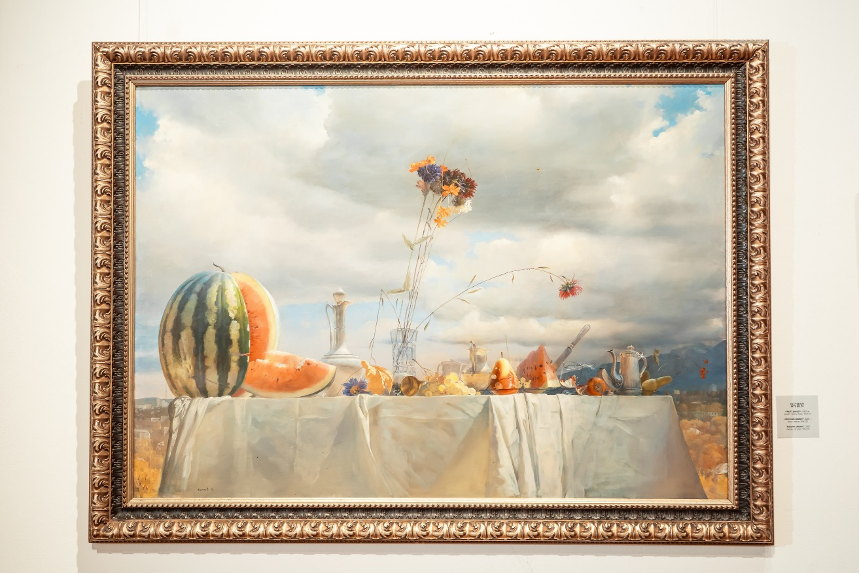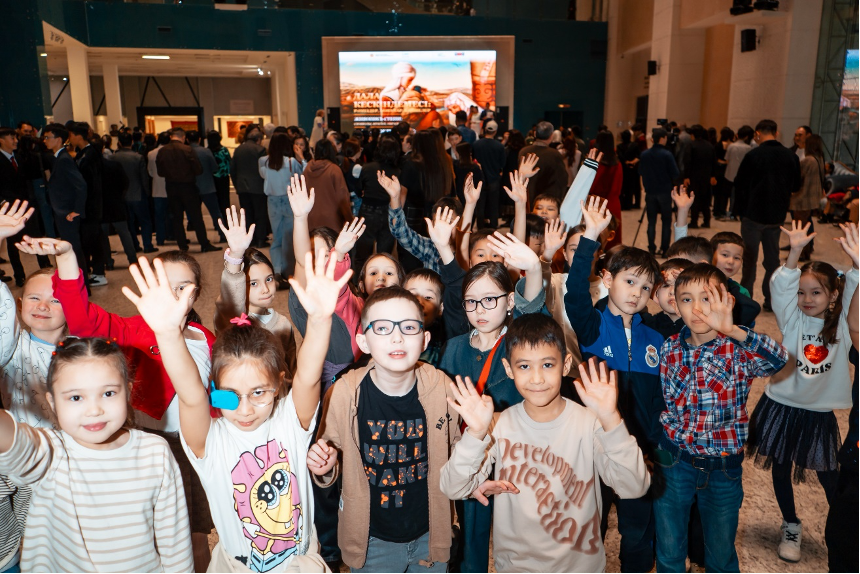
The main Museum of the country was opened to the public on July 2, 2014, as part of the implementation of the “Cultural Heritage” State program.

Gobelin Tapestry, diptych. (the author is unknown)
At present, the National Museum is a recognizable and beloved place of our country.
Over such a ten-year period, the museum has hosted many bright exhibitions that have become the events in the cultural life of Kazakhstan: the legendary “East-West” exhibitions, exhibition of weapons art from the Hermitage collection (St. Petersburg), “Terracotta Army of Emperor Qin Shi Huang” – from the National Museum of China (Beijing), “Paul Serusier and Brittany”.
“The current jubilee exhibition demonstrates a history of the development of the Kazakh national painting school as a unique, original, bright phenomenon. It draws attention to the domestic art of all lovers, connoisseurs of painting and those who discover this diverse world of Kazakh painting for the first time, which will be able to captivate the sophisticated modern spectator. The exhibition is based on the museum’s art collections: a collection of paintings, graphics, sculptures, decorative, applied and jewelry art. In total, about 250 works by 50 authors are collected at the exhibition”, - noted Olga Baturina, curator of the exhibition and art expert.

At the first tour, with the curator of the exhibition, professor of art history – Olga Baturina
The exhibition features a bright spot of the large felts and tapestries: “Qanbaq” (rolling stone), “Kyui” by Zamzagul Oralbayeva and a monumental tapestry triptych by an unknown author (exhibited for the first time in the history of the National Museum). The tradition of felting and weaving, going back to the depths of centuries in Kazakh culture, continues in the work of contemporary artists today.
“The hall provided by the National Museum of Kazakhstan – one of the largest and most central rooms – is 1100 square meters. This space will be allowed for the most expressive and effective exposition, including the best works of recognized masters of Kazakhstan’s art, as well as the works of young talented authors”, - emphasized Zaure Konysbekova, the Head of the Marketing and Creative Industry Department of the National Museum of Kazakhstan.
The first section of the exhibition is dedicated to the historical images, plots and themes. Its name “Ancestral Spirit’’ is symbolic and poetic, showing the archetypes of national history. The next big section of the exhibition is the “Family. Love. Spring. Childhood’’. The bright, warm, emotional images of the classics of Kazakh painting: Aisha Galimbayeva, Gulfairus Ismailova, Moldakhmet Kenbayev, Kamil Shayakhmetov, Kenzhebay Duisenbayev, Olga Kuzhelenko, Mariya Lizogub, Tokbolat Togusbayev, Bakhtiyar Tabiyev, Magaui Amanzholov, Dulat Aliyev and Mikhail Antonyuk tell about the most important and eternal things in every person’s life.
The center of the exposition at the exhibition is the “Masters and masterpieces’’, which includes the creative works of the luminaries of Kazakh painting, which have become programmatic in their work: “On the virgin land. Yereymentau’s offskips’’ by Aubakir Ismailov, “Foothills of Brichmulla’’ by U.Tansykbayev, “Aura of tenderness’’ by K.Mullashev, “Allegory’’ by J.Kairambayev, “Atameken’’ by A.Yesdauletov, "Echoes of olden times" by A.Bapanov, "Oriental bazaar" by M.Khitakhunov, "Portrait of Darya’s daughter" by M.Kalimov, "Airport on the virgin land" by R.Yesirkeyev, "Baba-Ata aul" by U.Yevseyev, "The Red Horse" by Z.Tussipov, "Kelinshek" (bride) by E.Tolepbayev, "Cattleman" by V.Tovtin. Also, there are the creative works by talented painters whose work has become famous over the years of independence: E.Palymbetov, K.Azhibekov, B.Burdesbekov, Y.Kamelin, A.Terekhov, P.Belov, Kozhakhan Shaaryn and others.

Kamil Mullashev, Honored Worker of Kazakhstan, (against the background of his work “Aura of tenderness”, 2000).
A separate section of the exhibition is dedicated to the landscape painting, as one of the important themes of Kazakh fine arts. “Poetry of mountains and steppes” – the works of outstanding artists of Kazakhstan are presented here: N.Khludov, A.Cherkassky, J.Shardenov, S.Aitbayev, S.Kenzhebayev, V.Eifert, V.Kolodenko, A.Sapugov, L.Leontiev, Sakhi Romanov, A.Shkolnyi, A.Nakisbekov, A.Stepanov, I.Kvachko, as well as painting of contemporary landscape painters: M.Baitenov, E.Fridlin, M.Nurgozhin, A.Abzhanova, T.Baigaliyev, M. Kalkabayev.

“Mountain landscape” by Nikolay Khludov, 1900.
“Many of the works at this exhibition are exhibited for the first time in the history of the museum or after a long period of storage in the collections. Some of them underwent a complex restoration before being presented to the audience in the halls of the museum. These include the paintings “On the virgin land. Yereymentau’s offskips’’ by Aubakir Ismailov (1958) and “Morning in Tengiz" (1972) by Mikhail Shatalov” – professor of art history, Olga Baturina, continued to introduce the unique exposition to the first guests of the exhibition.
A final section of the exhibition presents a panorama of contemporary art in Kazakhstan. The exhibition includes the most interesting works of Kazakhstan’s contemporary art. Artistic experiments with form, color, textures, images and formats, updating expressive techniques and searching for a new visual language that allows you to express the complexity and diversity of the modern world in the works of: S.Bayaliyev, A.Rorokin, A.Menlibayeva, A.Shalbayev, A.Akhmedyarov, G.Telgoziyev, S.Atabekov, R.Abdulov, R.Slekenov, M.Bekeyev, G.Goncharova, N.Khamidova, D.Nuger.

“Autumn dessert” by Peter Belov, 2005 
“Kelinshek” (Bride) by Yerbolat Tolepbay, 2009

Young visitors at the jubilee exhibition in the museum
About the National Museum: The basis of the museum collection consists of artifacts, identified as part of this state program. The museum complex is located at the area of 74,000 m2. It is worth noting that 20 halls of the permanent exhibition represent the history and culture of the country from ancient times until present day, as well as immerse in the original culture of Kazakhstan. Over 200,000 items of the museum collections are systematized in a single database, developing and updating the digital museum communications platform. The museum implements the cultural, educational and scientific projects to preserve, study and promote a cultural heritage of Kazakhstan, the inheritor of the steppe civilization and driver of economic development of the Central Asian region. The National Museum of Kazakhstan has accumulated invaluable experience in intercultural interaction based on the partnerships with cultural institutions in Central Asia, Southeast Asia, the CIS, Europe and influential international organizations.
The jubilee exhibition at the National Museum is supported by the Kazakh Ministry of Culture and Information.
From April 5 to July 31, 2024.
Photo credit: Ramina Ashim









